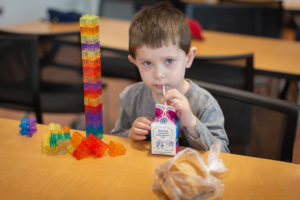 During the 2021-22 school year, the programs distributed the equivalent of 2.1 million meals to nearly 8,000 students in 270 schools. This year, we expect to exceed both meals provided and children served as we work to get additional fresh food out to partner schools.
During the 2021-22 school year, the programs distributed the equivalent of 2.1 million meals to nearly 8,000 students in 270 schools. This year, we expect to exceed both meals provided and children served as we work to get additional fresh food out to partner schools.
Since the programs’ inception 15 years ago, one feature has remained the same: the Food Bank’s Children’s Programs are referral driven. School staff, including teachers, social workers, nurses and cafeteria workers can all refer children into the program based on what they know about the students and their circumstances at home. Children will often talk to trusted school staff about not having enough food to eat at home or exhibit behaviors associated with chronic food insecurity.
Children who need the nutritional support the programs provide but are ineligible for more formal safety net programs can still receive food. These are the children who “slip through the cracks” but still have demonstrable need.
The benefit of referral forms was underscored in a recent survey of BackPack households: 58% of participating families did not receive SNAP benefits. Within that group, over 55% were ineligible for the benefit. The Food Bank’s Children’s Programs will give these hungry children food regardless of their status in more stringent programs. (In an effort to encourage enrollment in SNAP, the Food Bank will distribute information on the program to all participating families.)






Your article helped me a lot, is there any more related content? Thanks!
Thank you very much for sharing. Your article was very helpful for me to build a paper on gate.io. After reading your article, I think the idea is very good and the creative techniques are also very innovative. However, I have some different opinions, and I will continue to follow your reply.
I ordered an essay at the last minute, and was pleasantly surprised how quickly and efficiently this service handled the task https://www.metrotimes.com/sponsored/want-to-buy-essay-online-top-10-trusted-writing-services-to-go-for-30728421 . Not only did they meet the deadlines, but they also provided top-notch essays. This was a salvation for me!
Thank you so much for the tip.
Unlock your full academic potential with a powerful tool I’ve recently discovered. This website nurse writers has redefined the way I approach my studies. With the option to order custom essays online, I’ve gained the freedom to explore my passions and delve deeper into my coursework. It’s not just about getting essays done; it’s about realizing your true academic capabilities.
Thank you very much for sharing, I learned a lot from your article. Very cool. Thanks. nimabi
I really loved reading your blog. It was very well authored and easy to undertand. Unlike additional blogs I have read which are really not tht good. I also found your posts very interesting. In fact after reading. I had to go show it to my friend and he ejoyed it as well!
Your article helped me a lot, is there any more related content? Thanks! https://www.binance.com/ro/join?ref=UM6SMJM3
Thanks for sharing. I read many of your blog posts, cool, your blog is very good. https://www.binance.info/uk-UA/join?ref=PORL8W0Z
I really enjoy the post. Really Great.
Euro 2024 groups. Avn 2024. wlw.su 2024 ford super duty.
Rolling stones tour 2024. 2024 honda civic hybrid.
2024 nfl draft class.
Thanks a ton! It is definitely an awesome website. fragen Sie nach den Preisen von angusta 100 mcg in den Niederlanden
Hello Guys, I am a friendly person I alove to b here and meet U